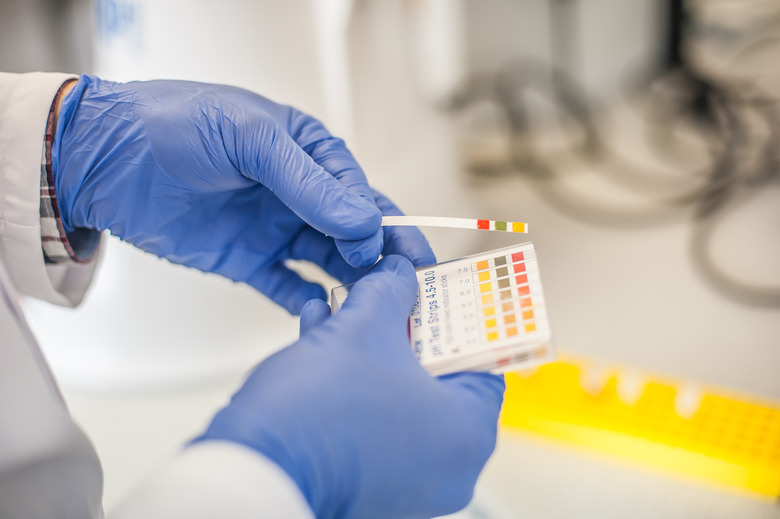What Happens When A Base Is Added To A Buffer Solution?
A buffer solution is a water-based solution with a stable pH. It is made by mixing a large volume of a weak acid or weak base with its conjugate base or acid. When you add small quantities of an acid or alkali (base) to it, its pH does not change significantly. In other words, the buffer solution stops the acid and base from neutralizing each other.
TL;DR (Too Long; Didn't Read)
When a base is added to a buffer solution, the pH does not change. The buffer solution prevents the base from neutralizing the acid.
Acidic and Alkaline Buffer Solutions
Acidic and Alkaline Buffer Solutions
The pH scale reveals how acid or alkaline a water-based solution is. Acidic solutions contain more hydrogen ions than hydroxide ions, while alkaline solutions contain more hydroxide ions than hydrogen ions. On the scale of 0 to 14, with 0 to the left and 14 to the right, acidic buffer solutions have a pH level of less than 7. They are typically made from a weak acid and a conjugate base – often a sodium salt. Alkaline buffer solutions have a pH level of more than 7, and they are usually made from a weak base and one of its salts. To change the pH of a buffer solution, change the ratio of acid-base to salt or choose a different acid or base and one of its salts.
Le Chatelier's Principle
Le Chatelier's Principle
Le Chatelier's Principle helps you work out what happens in a buffer solution. The principle states that if you change the conditions of a dynamic equilibrium, the position of equilibrium moves to counteract the change. For example, in an acidic buffer solution of ethanoic acid and sodium ethanoate, the position of equilibrium is well to the left on the scale because ethanoic is a weak acid. When you add sodium ethanoate, which is the conjugate base, you add a lot of extra ethanoate ions, which tips the position of the equilibrium even further to the left.
Adding a Base to a Buffer Solution
Adding a Base to a Buffer Solution
If you add a base to a buffer solution, the hydrogen ion concentration decreases by less than the amount expected for the quantity of base added. The acid and its conjugate base consume the hydroxide ions. The pH of the solution does not rise significantly, which it would do if the buffer system was not in use. This is because, as per Le Chatelier's Principle, the position of equilibrium moves to the right to make up for the loss of hydrogen ion in the reaction with the base.
Cite This Article
MLA
Gillespie, Claire. "What Happens When A Base Is Added To A Buffer Solution?" sciencing.com, https://www.sciencing.com/happens-base-added-buffer-solution-6365618/. 30 April 2018.
APA
Gillespie, Claire. (2018, April 30). What Happens When A Base Is Added To A Buffer Solution?. sciencing.com. Retrieved from https://www.sciencing.com/happens-base-added-buffer-solution-6365618/
Chicago
Gillespie, Claire. What Happens When A Base Is Added To A Buffer Solution? last modified March 24, 2022. https://www.sciencing.com/happens-base-added-buffer-solution-6365618/
